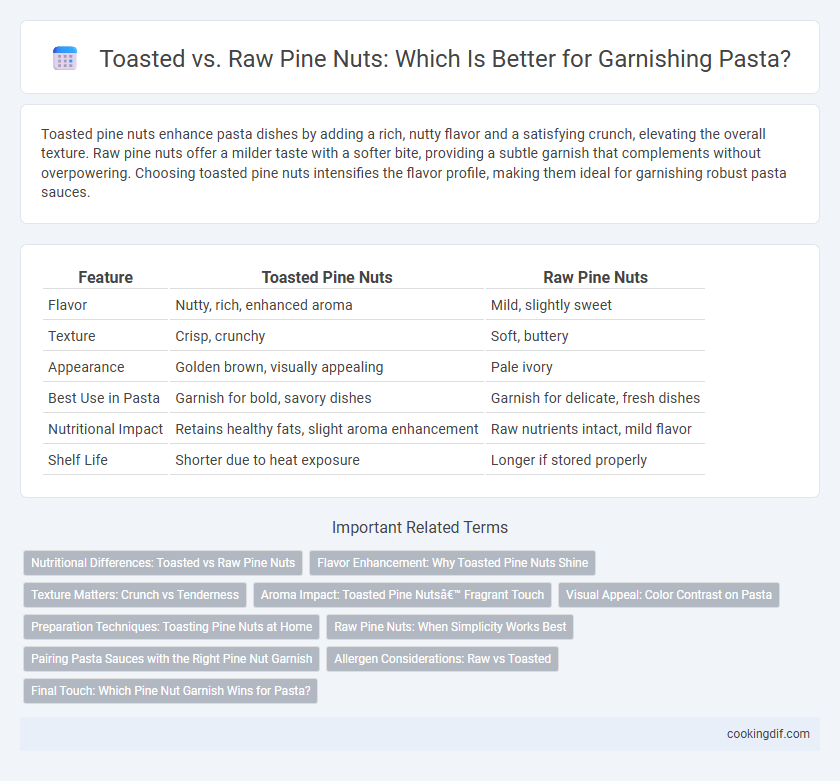Toasted pine nuts enhance pasta dishes by adding a rich, nutty flavor and a satisfying crunch, elevating the overall texture. Raw pine nuts offer a milder taste with a softer bite, providing a subtle garnish that complements without overpowering. Choosing toasted pine nuts intensifies the flavor profile, making them ideal for garnishing robust pasta sauces.
Table of Comparison
| Feature | Toasted Pine Nuts | Raw Pine Nuts |
|---|---|---|
| Flavor | Nutty, rich, enhanced aroma | Mild, slightly sweet |
| Texture | Crisp, crunchy | Soft, buttery |
| Appearance | Golden brown, visually appealing | Pale ivory |
| Best Use in Pasta | Garnish for bold, savory dishes | Garnish for delicate, fresh dishes |
| Nutritional Impact | Retains healthy fats, slight aroma enhancement | Raw nutrients intact, mild flavor |
| Shelf Life | Shorter due to heat exposure | Longer if stored properly |
Nutritional Differences: Toasted vs Raw Pine Nuts
Toasted pine nuts offer a richer flavor due to the Maillard reaction but experience a slight reduction in heat-sensitive nutrients such as vitamin E and certain antioxidants compared to raw pine nuts. Raw pine nuts retain higher levels of unsaturated fats and delicate vitamins, providing a more nutrient-dense garnish option for pasta dishes. Both forms deliver healthy fats, magnesium, and protein, though toasting enhances texture and taste at the expense of some nutritional potency.
Flavor Enhancement: Why Toasted Pine Nuts Shine
Toasted pine nuts provide a deeper, richer flavor with a nutty, slightly caramelized taste that enhances the overall profile of pasta dishes. The toasting process releases essential oils, intensifying their aroma and adding a crunchy texture that contrasts with soft pasta. Raw pine nuts lack this flavor depth and crispness, making toasted pine nuts the superior choice for a garnish that elevates the dish.
Texture Matters: Crunch vs Tenderness
Toasted pine nuts provide a crunchy texture that enhances the mouthfeel of pasta dishes, creating a satisfying contrast with al dente noodles. Raw pine nuts offer a tender, buttery softness that blends seamlessly into sauces and toppings, promoting a subtle richness. Choosing toasted versus raw pine nuts impacts the overall sensory experience, balancing crunchiness against smooth creaminess for optimal garnish effect.
Aroma Impact: Toasted Pine Nuts’ Fragrant Touch
Toasted pine nuts release a rich, buttery aroma that enhances the overall sensory experience of pasta dishes by adding a warm, nutty fragrance. The toasting process intensifies their essential oils, creating a more pronounced and inviting scent compared to raw pine nuts. This aromatic boost elevates the garnish, making toasted pine nuts a preferred choice for intensifying flavor complexity and visual appeal.
Visual Appeal: Color Contrast on Pasta
Toasted pine nuts exhibit a warm golden-brown hue that creates a striking color contrast against the pale cream or red tomato sauce of pasta, enhancing the dish's visual appeal. Raw pine nuts, being pale and ivory, blend more subtly with the pasta, providing a softer and more understated garnish. The toasted variety's deeper color elevates the presentation by adding texture and vibrancy, making each bite visually enticing.
Preparation Techniques: Toasting Pine Nuts at Home
Toasting pine nuts enhances their nutty aroma and adds a crunchy texture that elevates pasta dishes, achieved by heating them over medium heat in a dry skillet until golden brown. Raw pine nuts offer a milder flavor and softer bite, often used when a subtler garnish is preferred. Home toasting allows precise control over browning, ensuring optimal flavor development without bitterness or burning.
Raw Pine Nuts: When Simplicity Works Best
Raw pine nuts provide a delicate, buttery flavor and creamy texture that enhances pasta dishes without overpowering other ingredients. Their subtle sweetness pairs perfectly with fresh herbs, olive oil, and Parmesan, offering a pure, natural taste that toasted pine nuts can sometimes mask. Using raw pine nuts ensures a clean, authentic garnish, highlighting the simplicity and freshness of quality pasta recipes.
Pairing Pasta Sauces with the Right Pine Nut Garnish
Toasted pine nuts offer a richer, nuttier flavor and a crunchier texture, enhancing the complexity of creamy or tomato-based pasta sauces, such as Alfredo or marinara. Raw pine nuts provide a mild, buttery taste that complements delicate sauces like olive oil and garlic or light pesto without overpowering them. Selecting the right pine nut garnish intensifies the overall dish by balancing flavors and adding contrasting textures tailored to the pasta sauce profile.
Allergen Considerations: Raw vs Toasted
Toasted pine nuts for pasta garnish may have altered allergenic proteins due to heat exposure, potentially reducing allergenicity compared to raw pine nuts, though reactions can still occur in sensitive individuals. Raw pine nuts retain their natural allergenic proteins and pose a consistent risk for those with tree nut allergies. Chefs should clearly label dishes to inform diners with allergies about the use of raw or toasted pine nuts to prevent adverse allergic reactions.
Final Touch: Which Pine Nut Garnish Wins for Pasta?
Toasted pine nuts deliver a richer, nuttier flavor and a crunchier texture that elevates pasta dishes more effectively than raw pine nuts, which offer a mild, slightly resinous taste with a softer bite. The toasting process enhances the oils in pine nuts, creating a golden-brown finish that adds visual appeal and depth to pasta garnishes. For a final touch, toasted pine nuts consistently outperform raw ones by intensifying aroma and providing a satisfying contrast to creamy sauces and tender pasta.
toasted pine nuts vs raw pine nuts for garnish Infographic

 cookingdif.com
cookingdif.com